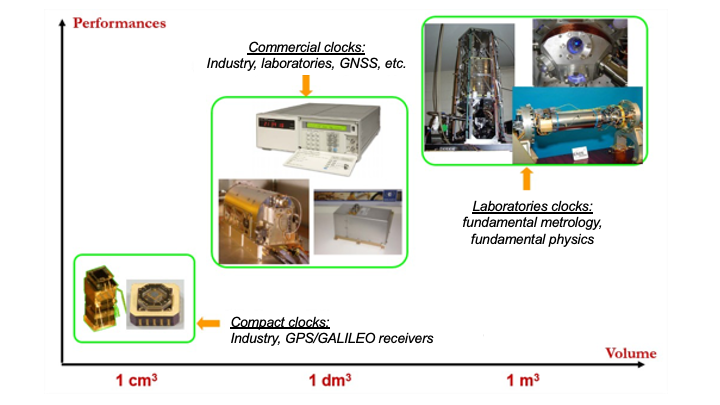Atomic clocks
The operating principle an atomic clock is based on the oscillator frequency servo control on an absolute frequency reference corresponding to the transition frequency between two quantum states of an atom, an ion or a molecule. The clock’s useful signal is generated by an oscillator whose type depends on the considered frequency range. In order to compare the oscillator frequency ν to the atomic reference frequency νat, a portion of this signal is extracted. A frequency synthesis chain allows to adapt the oscillator frequency to the atomic reference frequency range by generating a probing signal at frequency νprobe, close to νat. This synthesis is also used to finely control the signal characteristics that will interact with the atoms: amplitude, addition of a frequency offset, amplitude and/or frequency modulation, etc.

A large variety of atomic clocks rely on the principle described above. Depending on the applications type, they differ in their ability to be transported (mass – volume – power consumption) and in their performance in terms of:
- Frequency stability – Stability describes the statistical fluctuations of the frequency that the clock delivers.
- Frequency Accuracy – Accuracy is the ability to self-assess frequency shift without the need for comparison with a more accurate reference clock. In this case, the frequency shift due to systematic effects can be corrected, but this correction can only be done with a certain uncertainty representing the clock inaccuracy.
Operating in the optical domain, the best clocks today have frequency stabilities and accuracies in the range of 10-18, which would correspond to an error of about 1 second over a time span equivalent to the age of the universe (but of course it doesn’t mean we know the age of the universe to within 1s as there was no such clock at the moment of the bigbang !). They are developed in major metrology laboratories around the world and have a volume of the order of one cubic meter (plus control electronics which typically fills up a smal room…). They are used to carry out experiments in fundamental metrology but also in fundamental physics, among other to test Einstein’s theory of relativity.
Many essential applications for daily life (telecommunications, internet, Galileo, GPS, transportation, energy distribution, …) require atomic clocks but with lower performance and smaller dimensions. Current research aims at miniaturizing atomic clocks to centimetric dimensions, or even smaller, in order to install them in GPS receivers and in the longer term in cell phones.

